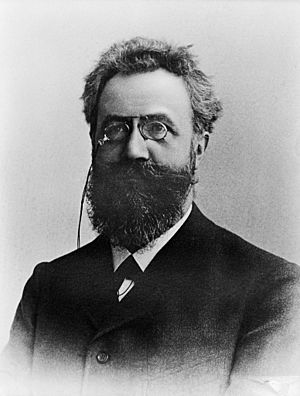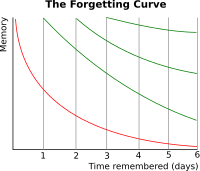Hermann Ebbinghaus facts for kids
Quick facts for kids
Hermann Ebbinghaus
|
|
|---|---|
 |
|
| Born | 24 January 1850 Barmen, Rhine Province, Kingdom of Prussia
|
| Died | 26 February 1909 (aged 59) |
| Known for | Serial position effect, Über das Gedächtnis |
| Scientific career | |
| Fields | Psychology |
| Institutions | University of Berlin, University of Breslau, University of Halle |
| Influences | Gustav Fechner |
| Influenced | Lev Vygotsky, Lewis Terman, Charlotte Bühler, William Stern |
Hermann Ebbinghaus (born January 24, 1850 – died February 26, 1909) was a German psychologist. He was a pioneer in studying memory using scientific experiments.
Ebbinghaus is famous for discovering the forgetting curve, which shows how quickly we forget things. He also found the spacing effect, which means we remember things better if we learn them over time instead of all at once. He was also the first to describe the learning curve, which shows how we learn new information.
Contents
Early life and education
Hermann Ebbinghaus was born in Barmen, a town in what was then the Kingdom of Prussia. His father, Carl Ebbinghaus, was a rich merchant. We don't know much about Hermann's early childhood, but he was raised in the Lutheran faith. He went to a local school called a Gymnasium.
When he was 17, in 1867, Ebbinghaus started studying at the University of Bonn. He planned to study history and philology (the study of language). However, he soon became very interested in philosophy.
In 1870, his studies were paused because he joined the Prussian Army during the Franco-Prussian War. After his time in the military, Ebbinghaus finished his main university project. He earned his doctorate degree on August 16, 1873, when he was 23 years old. For the next three years, he spent time at the University of Halle and the University of Berlin.
Professional career
After getting his PhD, Ebbinghaus traveled to England and France. He worked as a tutor to support himself. In London, he found a book by Gustav Fechner called Elemente der Psychophysik (Elements of Psychophysics). This book inspired him to start his famous experiments on memory.
When he returned to Germany, Ebbinghaus began his studies at the University of Berlin. In 1879, he started his important memory research there. He also founded the third psychological testing lab in Germany.
In 1885, Ebbinghaus published his most important work, Über das Gedächtnis (On Memory). This book was later translated into English as Memory: A Contribution to Experimental Psychology. Because of this major publication, he became a professor at the University of Berlin that same year. In 1890, he helped start a psychology journal called Zeitschrift für Physiologie und Psychologie der Sinnesorgane.
In 1894, Ebbinghaus moved to the University of Breslau (which is now in Poland). While there, he worked on a project to study how children's mental abilities changed during the school day. Even though we don't know exactly how they measured these abilities, their work helped create the basis for future intelligence testing. At Breslau, he also started another psychological testing laboratory.
In 1902, Ebbinghaus published another book called Die Grundzüge der Psychologie (Fundamentals of Psychology). It was very popular and continued to be read for many years. In 1904, he moved to the University of Halle, where he spent the last years of his life. His final book, Abriss der Psychologie (Outline of Psychology), was published in 1908. This book was also very successful and was re-released many times.
Hermann Ebbinghaus died on February 26, 1909, at the age of 59, from pneumonia.
Research on memory
Ebbinghaus wanted to prove that complex mental processes, like memory, could be studied scientifically through experiments. Many people at the time thought this was impossible.
To make sure his experiments were fair, Ebbinghaus needed something easy to memorize that didn't have any previous meaning or connections. Regular words would be too complicated because people already know them. So, he created what are now called "nonsense syllables" (also known as CVC trigrams).
A nonsense syllable is a combination of a consonant, a vowel, and another consonant. The consonants don't repeat, and the syllable doesn't have any existing meaning. For example, "DAX," "BOK," and "YAT" would be good nonsense syllables. He ended up with 2,300 such syllables.
Ebbinghaus would pick random syllables from a box and write them down. Then, he would read them aloud at a steady pace, using a metronome. He would try to recall them at the end of the process. One study alone involved him reciting syllables 15,000 times!
Key findings
In 1885, Ebbinghaus published his important book Über das Gedächtnis ("On Memory"). In it, he described his experiments on himself to understand how we learn and forget.
He made several discoveries that are still important today:
- Memory is orderly: By using his 2,300 nonsense syllables, he found that memory follows certain rules.
- The forgetting curve: This is perhaps his most famous discovery. The forgetting curve shows that we lose information very quickly after we learn it. The fastest forgetting happens in the first 20 minutes, and a lot is forgotten within the first hour. After about a day, the rate of forgetting slows down a lot.

- The learning curve: This curve shows how fast we learn new information. We learn a lot very quickly after the first try. Then, we learn less and less new information with each repetition. Like the forgetting curve, the learning curve is also a curve that levels off.
- The serial position effect: This effect explains how the position of an item in a list affects how well we remember it.
- Recency effect: We tend to remember the most recent information better because it's still in our short-term memory.
- Primacy effect: We also tend to remember the first items in a list better. This is because we often repeat them more, which helps move them into long-term memory.
- Savings: This idea refers to the amount of information that stays in our subconscious mind, even if we can't remember it consciously. Ebbinghaus would memorize a list perfectly, then wait until he couldn't recall any items. When he relearned the list, he found he learned it faster the second time. This difference in learning speed was what he called "savings."
Before Ebbinghaus, most studies of memory were done by philosophers who just observed and thought about memory. Ebbinghaus changed this by using scientific experiments. His work quickly led to a lot more memory research, especially in the United States.
Famous psychologists like William James called Ebbinghaus's studies "heroic" and "the single most brilliant investigation in the history of psychology."
Limitations
There were some limits to Ebbinghaus's memory research. The biggest one was that he was the only person in his studies. This makes it harder to know if his findings apply to everyone. Even though he tried to keep his daily routine very controlled, using only himself as a subject meant his results might not be true for the general population. Also, when the researcher is also the participant, there can be some personal bias.
Sentence completion, illusion and research report standardization
Ebbinghaus created the first sentence completion exercises. He used them to study the abilities of schoolchildren. Later, Alfred Binet used these exercises in his famous Binet-Simon intelligence scale, which measures intelligence. Sentence completion is still used today in memory research and in psychotherapy to help understand people's thoughts.
Ebbinghaus also discovered an optical illusion that is now named after him: the Ebbinghaus illusion.
In this illusion, two circles of the same size are placed next to each other. One is surrounded by large circles, and the other is surrounded by small circles. This makes the first circle appear smaller than the second, even though they are identical. This illusion is used a lot in cognitive psychology to study how our perception works in the human brain.
Ebbinghaus also helped create the first standard way to write a research report. He organized his paper on memory into four clear parts: the introduction, the methods (how he did the experiment), the results (what he found), and the discussion (what the results mean). This clear structure was so good that it became the standard way for scientists to write their research papers.
Influences
One major influence on Ebbinghaus was Gustav Fechner's book Elemente der Psychophysik ("Elements of Psychophysics"). Ebbinghaus bought this book second-hand in England. He was so impressed by Fechner's careful mathematical methods that he wanted to do the same for psychology. Ebbinghaus even dedicated his second book, Principles of Psychology, to Fechner, writing, "I owe everything to you."
Selected publications
- Ebbinghaus, H. (1885). Memory: A contribution to experimental psychology. New York: Dover.
- Ebbinghaus, H. (1902). Grundzüge der Psychologie. Leipzig: Veit & Co.
- Ebbinghaus, H. (1908). Psychology: An elementary textbook. New York: Arno Press.
See also
 In Spanish: Hermann Ebbinghaus para niños
In Spanish: Hermann Ebbinghaus para niños


